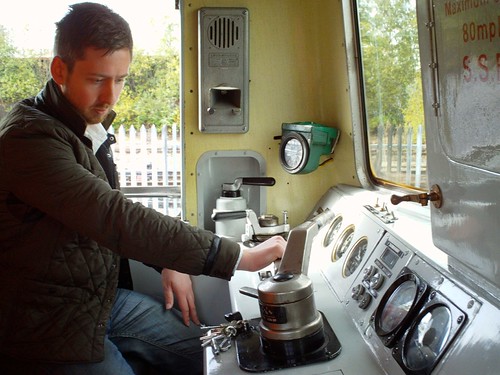Looking around, I've not found anything good enough or cheap enough to use, nor anything that's actually good-looking or remotely fun to use. So new projects, here we come.
The Idea
The idea is to build a pseudo-realistic control panel, that mimics the pre-requisite controls, and the type of touch and feel found in the cab of a real train. Because I don't have a specific train cab in mind, I'm not replicating a prototype panel in existence, but taking the essence of the feel of the cab and condensing that into something small enough to be used practically at home.
After seeing the InterCity APT a few weeks back, I've been inspired by the simplicity and general layout of it's controls. Coupled with images scouted from Flickr and with Google, theres enough scope to do something that is original, yet quite obvious as to purpose.
The Look & Feel
I started researching and planning an older style panel, but gave up when I made little headway in sourcing real (actual used/new parts) or pseudo-real (stuff that vaguely looks like the real thing) levers and parts. It seemed I'd be forced to make replicas; either approximate in size, or scaled to fit, using vac-form plastic and wooden parts. While relatively straight forward for me, I just don't have the time or space to be doing that at the moment (though I'm really keen to build a mini-vac former so I can do it in the kitchen).
Having stared at the pictures of the APT cab, it dawned on me that not only can I build a modern cab using actual components (allowing me to get away from the "hand-made" look), but I'd have enough wiggle room to build something that could look like a prototype off Bombardier or Siemens' next design.
By using the same kind of switches and selectors as would be used in an actual cab, the panel should have the same feel - even with clunk-click selector switches for direction, and large illuminators for feedback. I'm not planning to use electronics parts (the kind you pick up at Maplin), but the regular day-to-day heavy duty controls that we use in proper control panels.
The Controls & Electronics
The manufacturers of train control systems, for the most part, use these electrical components in their panels - there will however be some difficulty in sourcing the two quadrant levers used for speed and braking, and any needle gauges (yup, seems like they're still being used). My initial thoughts are to utilise LCD displays for speed, braking and "general information" (i.e. the DCC train selected and other programming stuff).
I'm also considering how advanced it should be, as a keypad might be useful - then again, with the palette of functions in DCC, provided I settle on function numbers for each function layout-wide, there'll be actual buttons for those functions - two-way horn buttons, light switches, pantograph controls etc. A ball-mouse or trackpad is probably overkill, but worth considering for JMRI integration.
It'll basically be a panel building job, tied into an Arduino based I/O card, and a couple of extra bits of electronics for the gauges. I'll also finish it with nice rugged connectors for power, data and USB (interfacing the Arduino).
For the most part, I'll used Telemecanique buttons and switches, though the quadrants might be a custom build using Telemec bits and bobs, and some scratch building for the framework. The LCD units will be of course interfaced with the Arduino, but are as close to what would be used, that they'll be fine. I'm not going to use little LEDs etc, but instead use actual pilot lights (big, but the real thing).
I've sourced a large angled console enclosure, that features a display panel - and excellent mimic of the real thing. Using aluminium, I'll build one or two brackets, one to hold a mini LCD display (for JMRI) and one to hold some additional controls I might implement in the future. I'd love a touchscreen, but I think it might knock the panel over using it, so that'll be a separate project (a signal operators panel I think).
It'll be tied together by a paint job to the case (greyish blue/bluish grey) and polycarbonate-coated polyester labels (again what's used in combination with traffolyte for the real thing).
I'll of course go balls-out on the internal cable looms, even though it'll spend most of it's time sealed. Might put thumb-screws on for easy internal access...
DCC Integration
The biggest issue that was always going to present itself, was integration with a DCC system. After spending time chatting with the folks at MERG, it seems that my original thoughts are correct, and that unless I plan to write an entire DCC stack (ermmm, no), then I need something else to do the DCC control.
So this leads onto JMRI and CAN-Bus.
I have two options at this stage, both involve JMRI as the core DCC control stack. The panel can either interface through customer code using USB and acting as an input to JMRI, or it can be part of a CAN-Bus network, and the CAN-Bus controller can interface JMRI. Thanks to the work at MERG, the latter looks to be the easiest.
More to come, plus I'll start posting pictures of parts as they arrive. Lots to think about on the code side, and integration, so again, more to come.
Stay tuned.


